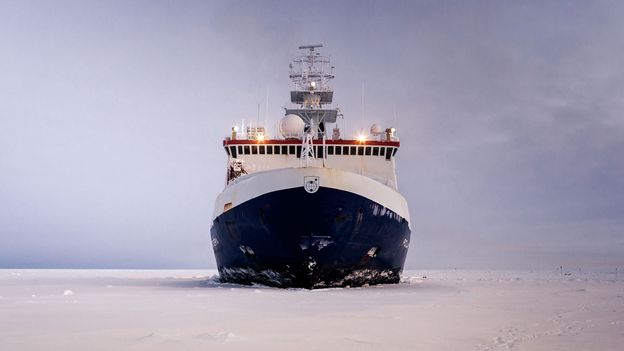Deciphering the rhythm of life on the ship is made easier for me by my cabinmate, Nicole Hildebrandt. This is her eighth year and tenth expedition on board Polarstern. A researcher at AWI, she is part of Mosaic’s ecology team, sampling zooplankton. Zooplankton, small marine organisms that carried by currents, are a crucial part of the Arctic food web – supporting life from whales to fish, and the seals and polar bears that eat the fish.
Hildebrant’s speciality is using a series of large nets, which she casts from the side of the ship into a hole in the sea ice where they can drift for up to 2,000m (6,500ft) in the water beneath. She knows the ship backwards and forwards, describing the circuitous paths through the warren of steep stairs and cramped corridors to reach more or less anywhere I want to go. She tells me when it is a good time to get your laundry done, and when to beat the dinner queues. Among her baggage she has brought a few things to make our cabin more homely – her own pillow and bedlinen, fairy lights and a selection of snacks not available on board
This is the first time Hildebrandt will be working on Polarstern through the Arctic winter. Among her supplies this time is a stash of vitamin D to compensate for the lack of sunlight. This first leg of the expedition is expected to end in mid-December, followed by a two-week journey back on another icebreaker, which will plough through the ice to get as close as possible to Polarstern so people, fuel and food can be transferred.
None of the first leg participants expect to be back for Christmas. “I think it will be beginning of January. We won’t make new year,” says Hildebrandt.
Drifting time
In the first few days on board, sense of time on the ship dissolves. As we move east, through the Norwegian Sea to the Barents Sea, a muffled voice declares on the public announcement system, first in German then in English, that the clocks will go forward one hour that night. This happens every afternoon for the first week. Like many things on the ship, it happens in a strictly regulated way. Time will be lost in three 20-minute intervals spread throughout the night, so that the shortening of the shifts is spread fairly between the three night watches. Each night the minutes between 20:00 and 20:21, between midnight and 00:21, and then 04:00 and 04:21 go missing.
Compounding this sense of slipping time is the lack of windows in the communal spaces in the ship. On C-deck is the Red Saloon, where most people spend their idle moments, lit by a soporific glow from yellow-shaded wall lamps. The ship rolls heavily in the swells, causing a pen hanging on a string on the saloon wall to swing like a pendulum. In the bar down on D-deck, a stool spins slowly by itself. It’s as if the Polarstern is rocking us to sleep, regardless of whether it is 21:00 or right after breakfast.






